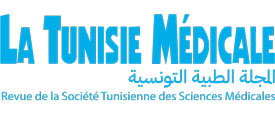Difficulté, discrimination et niveaux cognitifs des questions d'examens de microbiologie à la Faculté de médecine de tunis
##plugins.themes.academic_pro.article.main##
Résumé
RESUME
Introduction: Se basant sur différents indices (difficulté, discrimination) et les niveaux cognitifs de Bloom, nous avons évalué la qualité des questions de Microbiologie de la session principale 2012-2013 à la Faculté de Médecine de Tunis.
Méthodes: Nous avons analysé 70 questions: 16 (examen «A»), 28 («B1») et 26 («B2»), résolues respectivement par 533 (1ère année), 285 et 292 (3ème) étudiants. Pour chaque question, nous avons déterminé les indices de difficulté, discrimination et le plus haut niveau cognitif exploré. Les indices moyens de difficulté et de discrimination pour chaque examen et niveau cognitif, et ceux de discrimination pour chaque niveau de difficulté, ont été déterminés.
Résultats: Les 70 questions étaient de difficulté recommandée (0.58), bonne discrimination (0.31) et exploraient principalement (58.57%) le plus bas niveau cognitif. La difficulté était acceptable en 1ère et 3ème années; la discrimination respectivement marginale (0.27) et bonne (0.33). «A», «B2» et «B1» exploraient
respectivement, les bas, bas et hauts et les 3 ordres cognitifs.Chaque niveau cognitif, excepté l’intermédiaire, était de difficulté acceptable. La discrimination était bonne pour tous les ordres cognitifs excepté l’ordre bas de 1ère année (0.27). La discrimination était marginale pour les questions difficiles (0.29) et bonne pour les autres. Comparé à B2, B1 était plus à la portée, plus discriminatif (aucune question de mauvaise discrimination) et explorait tous les niveaux cognitifs.
Conclusion: Bien que notre étude ne permet que des conclusions limitées à des questions spécifiques, elle pourrait servir de modèle pour d’autres, similaires, visant à améliorer la qualité de nos examens.
Mots-clés :
Indice de difficulté, l'indice de la discrimination, la taxonomie de Bloom, examens de microbiologie##plugins.themes.academic_pro.article.details##
Références
- Vanderbilt A, Feldman M, Wood I. Assessment in undergraduate medical education: a review of course exams. Med Educ Online 2013; 18:1-5.
- Shafizan S. Item analysis of student comprehensive test for research in teaching beginner string ensemble using model based teaching among music students in public universities. IJER 2013; 1:1-14.
- Crowe A, Dirks C, Pat WP. Biology in Bloom: implanting Bloom's taxonomy to enhance student learning in biology. CBE Life Sci Educ 2008; 7: 368-381.
- Plack M, Driscoll M, Marquez M, Cuppernull L, Maring J, Greenberg L. Assessing reflective writing on a pediatric clerkship by using a modified bloom's taxonomy. Ambul pediatr 2007; 7: 285-91.
- Karelia B, Pillai A, Vegada B. The levels of difficulty and discrimination indices and relationship between them in four-response type multiple choice questions of pharmacology summative tests of year II M.B.B.S students. IeJSME 2013; 7: 15-20.
- Hingorjo MR, Farhan J. Analysis of one-best MCQs: the difficulty index, discrimination index and distractor efficiency. J Pass Med Assoc 2012;62: 142-7.
- MacAlpine M. A summary of methods of item analysis. CAA Centre Bluepaper 2, University of Luton 2002.
- Kartik A, Neeraj R. Itemized analysis of questions of multiple choice question (MCQ) exam. ISJR 2013; 2: 279-80.
- Tabatabaee M, Bahreyni TM, Derakhshan A, Dalloee M, Gholami H. Analytic assessment of multiple-choice tests. IJME 2003; 2:87-91.
- Henrysson S. Correction of item-total correlations in item analysis. Psyckometrika 1963; 28: 211-218.
- Theodorsson T, El Shafie K, Al Wardy N, Al Maherzi A, Al Shafaee M. Assessment of Family Doctors in Oman: getting the questions right preliminary findings of a performance analysis of multiple choice questions. Int J Med Educ 2010; 1: 2-5.
- Palmer EJ, Devitt PG. Assessment of higher order cognitive skills in undergraduate education: modified essay or multiple choice questions? Research paper. BMC med educ 2007; 7: 1-7.
